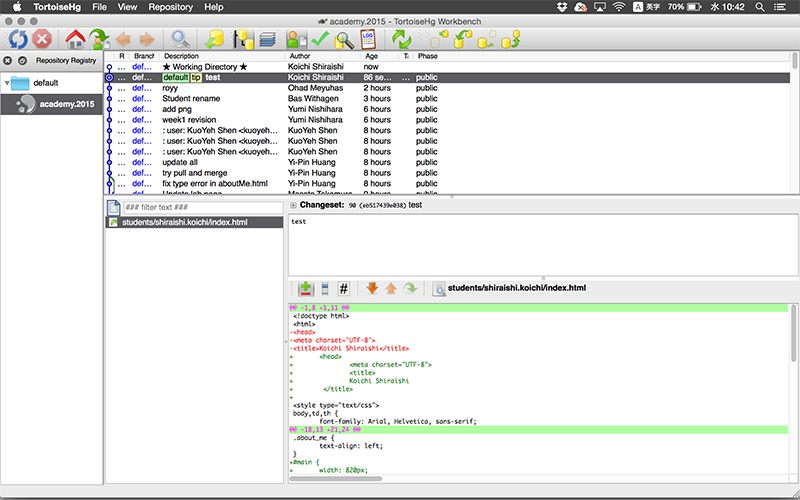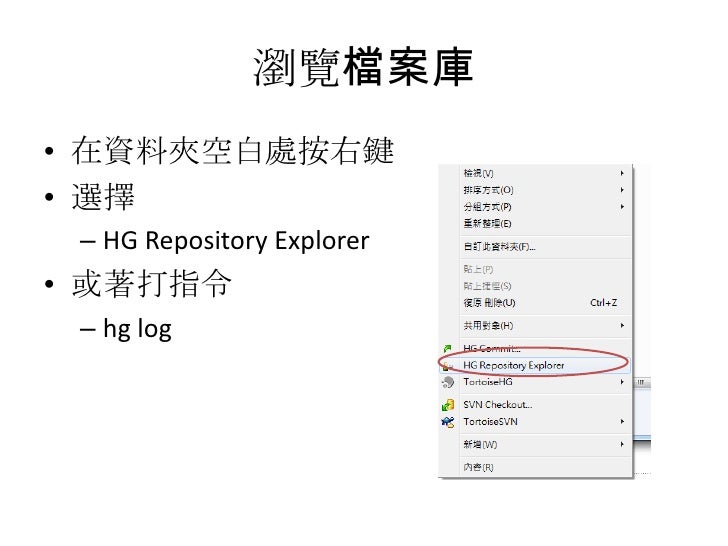
- Mercurial tortoisehg tutorial update#
- Mercurial tortoisehg tutorial Patch#
- Mercurial tortoisehg tutorial code#
- Mercurial tortoisehg tutorial series#
But it often works even if other approaches fail. This has the drawback that any commit message might be lost. Commit the local changes in a "fresh" changeset.
Mercurial tortoisehg tutorial update#
Mercurial tortoisehg tutorial Patch#
Finish the patch by selecting "Modify History" -> "Finish Patch" from the right click menu of the respective changeset. After updating some local files or changing the commit message, hit the "QRefresh" button. For this, select "Modify History" -> "Import to MQ" in the right click menu of the respective changeset. The most useful feature of that extension is probably to update an existing changeset. To activate the "mq" extension in TortoiseSVN, open the settings, select "Extensions" on the global settings tab and activate the checkbox next to "mq". The "mq" extension does *not* allow to modify pushed changes. It also allows to rebase changes to a new parent or to strip changes completely. The "mq" extension allows to modify (local) changesets after they have been committed. That might make it easier to get used to working with Mercurial. It allows to perform many hg operations using the context menu and toolbar buttons. TortoiseHg is a multi-platform graphical user interface for Mercurial repositories. username = Your Name color = histedit = pager = rebase = strip = pager = LESS='FSRX' less attend = help, annotate, cat, diff, export, glog, log, outgoing, incoming showfunc = True mode = terminfo # Custom colors ay = 244 color.orange = 202 color.lightyellow = 191 color.darkorange = 220 color.brightyellow = 226 status.modified = magenta bold status.added = green bold status.removed = red bold leted = cyan bold status.unknown = gray bold status.ignored = gray bold # Colors for each label log.branch = cyan log.summary = lightyellow log.description = lightyellow log.bookmark = green log.tag = darkorange log.graph = blue # Colors for each phase cret = blue bold changeset.draft = red bold changeset.public = orange desc.here = bold blue_background track.current = True glog = log -graph top = log -graph -l Tips for working with TortoiseHg They are a "lightweight" solution to named branches, which are not automatically updated for example.
Mercurial tortoisehg tutorial series#
In this section we use for example /octave.īookmarks are useful for identifying a series of commits. Students should publish their work as it progresses in a public repository.
Mercurial tortoisehg tutorial code#
This section is meant to provide tips for Summer of Code students working on new Octave features.


If your patch file is larger than the upload limit, you can compress it before uploading.

If you want to share your modifications, for example to fix a nasty bug #42424, you cannot just submit your changes to Octave's main repository.

1 Creating and submitting patches (changesets).


 0 kommentar(er)
0 kommentar(er)
